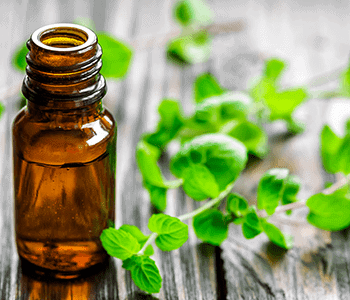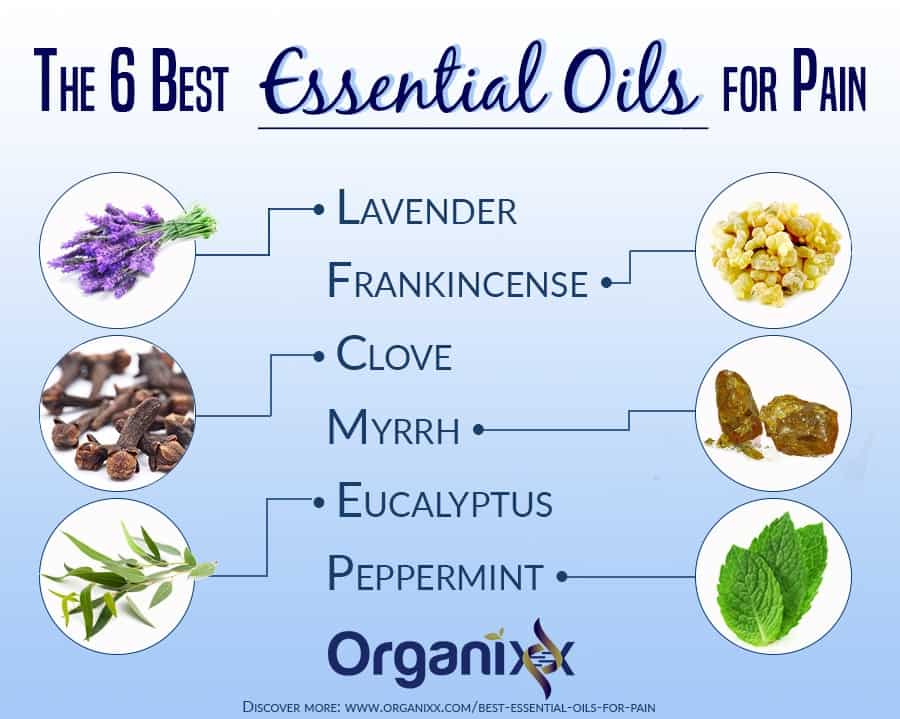6 of the Best Essential Oils for Pain
In a hurry? Click here to read the Article Summary...
Pain is big business. In a 2016 interview with CNBC, a senior analyst at Mizuho Securities USA was quoted as saying, “There [were] about 300 million pain prescriptions written in 2015.” She went on to explain that this equates to over $24 billion in sales, just in the United States − making pain relievers second only to cancer medications in pharmaceutical sales.
There’s a reason for this. Back in 1931, French physician Dr. Albert Schweitzer stated, “Pain is a more terrible lord of mankind than even death itself.” It’s true, pain − and especially chronic pain from conditions such as rheumatoid arthritis − is debilitating. Nobody wants it and it can feel impossible to deal with.
Sadly, pain is more rampant these days than diabetes, heart disease, or cancer combined. It’s the most commonly given reason for accessing the American health care system, with approximately 1 in 4 people suffering pain lasting longer than 24 hours, and millions more dealing with severe pain.
The Alarming Risks of Pain Medication
Taking pain medications to treat pain is not without risk, especially in the long term. In 2011 the Centers for Disease Control & Prevention (CDC) released an analysis of pain medication statistics for the years 1999 to 2008. Here is just some of what they reported:
- Overdose deaths involving opioid pain relievers (OPR), also known as opioid analgesics, have increased and now exceed deaths involving heroin and cocaine combined.
- Prescription painkiller overdoses killed nearly 15,000 people in the U.S. in 2008. (This is more than 3 times the 4,000 people killed by these drugs in 1999.)
- In 2010, about 12 million Americans (age 12 or older) reported non-medical use of prescription painkillers in the past year.
- Nearly half a million emergency department visits in 2009 were due to people misusing or abusing prescription painkillers.
- Sales of OPR quadrupled between 1999 and 2010. Enough OPR were prescribed in 2011 to medicate every American adult with a standard pain treatment dose of 5 mg of hydrocodone (Vicodin and others) taken every 4 hours for a month.
- Non-medical use of prescription painkillers costs health insurers up to $72.5 billion annually in direct health care costs.
Opiate Addiction & Side Effects
The number of people addicted to opiates is alarming, to say the least. The American Society of Addiction Medicine reported 1.9 million Americans addicted to prescription medications in 2016.
However, it’s not only the addictive potential that makes these common pain relievers harmful. There are side effects to consider. Opiate side effects can include:
- respiratory problems
- nausea
- constipation
- vomiting
- drowsiness
- dizziness
- brain damage
- liver damage
- paranoia
- over-sedation
It’s true that the statistics and side effects listed above are representative of the more potent pain medications (opiates) such as codeine, fentanyl, hydrocodone, meperidine, methadone, oxycodone, naxolone, and vicodin. But the over-the-counter pain meds that so many people take for various types of pain also come with a laundry list of potential pitfalls.
The Dangers of Over-the-Counter Drugs
 Statistics show that, in just seven months in 2014, Americans spent $1.65 billion on over-the-counter medications such as Advil, Tylenol, and Aspirin. If you do the quick math, that means another $1.18 billion was likely spent for the rest of 2014, taking the total to at least $2.83 billion.
Statistics show that, in just seven months in 2014, Americans spent $1.65 billion on over-the-counter medications such as Advil, Tylenol, and Aspirin. If you do the quick math, that means another $1.18 billion was likely spent for the rest of 2014, taking the total to at least $2.83 billion.
Tylenol (generic name acetaminophen) has long been considered one of the safest nonsteroidal anti-inflammatory drugs (NSAIDs), even above Aspirin or ibuprofen (Advil).
Most people are even likely under the assumption that regularly tossing back a few Tylenol to manage pain is harmless. However, long-term use of this relatively “gentle” drug has been coming under question.
While side effects from correct usage of Tylenol are somewhat rare, the extreme end of potential Tylenol damage includes jaundice, lip ulcers, yellow eyes, and liver damage (more on that below). Less worrying, but also possible effects, include: diarrhea, cramps, and sweating.
In 2015, the University of Leeds reported on the work of Professor Philip Conaghan of their School of Medicine. He and his team did a review of current research into Tylenol (known as paracetamol in many parts of the world), concluding:
“We think this study shows that the adverse health risks of taking paracetamol on a long-term basis are underestimated, particularly in relation to increased risk of heart, gastrointestinal and kidney problems.”
Tylenol Use Linked to Liver Damage and Even Liver Failure
There have also been a number of news reports about the link between Tylenol usage and severe liver damage.
For instance, in 2013 The Huffington Post reported that:
“Acetaminophen overdose sends as many as 78,000 Americans to the emergency room annually and results in 33,000 hospitalizations a year, federal data shows.
Acetaminophen is also the nation’s leading cause of acute liver failure, according to data from an ongoing study funded by the National Institutes for Health.”
Canadians have also been warned of the dangers of acetaminophen (Tylenol), with many doctors calling on Health Canada for better labeling and warnings of the dangers the drug presents. In September 2016, Dr. Michael Rieder, a pediatric clinical pharmacologist at Western University in Canada stated in a CBC news report that acetaminophen “is the most common cause of liver injury. Period. Full stop.”
One of the issues is that multiple products contain acetaminophen, which means it is very easy to exceed safe dosage levels − especially when taking multiple products to fight a cold or flu. Doctors have warned that it is especially critical to be cautious if you become dehydrated through vomiting or diarrhea and take acetaminophen, as even normally safe levels of the drug can become toxic in these situations.
Safety Issues with Ibuprofen (Advil)
Advil (ibuprofen), is another over-the-counter drug that many assume is safe. However, it’s prudent to be aware of the following warnings as listed on Drug.com:
“Ibuprofen can increase your risk of fatal heart attack or stroke, especially if you use it long term or take high doses, or if you have heart disease. Do not use this medicine just before or after heart bypass surgery (coronary artery bypass graft, or CABG).
Ibuprofen may also cause stomach or intestinal bleeding, which can be fatal. These conditions can occur without warning while you are using ibuprofen, especially in older adults.
Do not take more than your recommended dose. An ibuprofen overdose can damage your stomach or intestines. Use only the smallest amount of medication needed to get relief from your pain, swelling, or fever.”
Are There Risks Associated with Aspirin Use?
Even aspirin (acetylsalicylic acid) has some possible side effects that may come as a surprise, including:
- difficulty breathing
- confusion
- cloudy urine
- increased thirst
- internal bleeding
A 2014 review of current studies found that long term aspirin use “increased the risk of peptic ulcer by 30-60%.”
But what about the use of aspirin for those with heart issues, and avoiding heart attacks?
In 2014, a consumer update from the U.S. Food and Drug Administration (FDA), reported in Medical News Today, stated that “while daily low-dose aspirin use can prevent heart attack or stroke for those who have already had one, there is insufficient evidence to support its use for prevention of first-time heart attack or stroke.”
So with all of these issues with common pain relievers, is there anything that can support the body naturally?
Essential Oils for Pain
 Essential oils are not drugs, and according to FDA rules cannot be promoted as remedies or treatments for pain relief or of having analgesic properties.
Essential oils are not drugs, and according to FDA rules cannot be promoted as remedies or treatments for pain relief or of having analgesic properties.
However, they can be used to support good health and improved well-being, which may naturally lead to a reduced need for pain relievers in the first place.
What are essential oils? They are the extracts of plants, containing many chemicals and compounds that have been studied extensively for their health and healing benefits.
There are literally hundreds (if not thousands) of scientific studies available on the numerous benefits of essential oils and their components for human health.
And while it can’t be said that essential oils are without any side effects, they are far more rare and usually more in the realm of a skin rash or sneezing. That being said, it is always best to seek guidance from a qualified practitioner when using essential oils − especially if you have any health considerations.
6 Essential Oils that May Help Reduce the Need for Pain Meds
1. Frankincense
Known as Boswellia serrata in the plant world, frankincense is most famous for being mentioned in the Bible as a gift to the infant Jesus from the three Magi. The reason: it was considered a precious substance − perhaps due to its healing qualities.
In modern times, frankincense oil has been studied in relation to pain. For example, a 2008, double-blind, randomized trial reported in the journal Arthritis Research & Therapy looked into the effects of a frankincense extract called 5-Loxin® on joint pain in the knee from osteoarthritis. The researchers reported subjects experienced “significant” reduction in pain, and improvement in knee joint functions, in some cases in just 7 days.
Most pain is a result of inflammation. Research published in 2011 in the Indian Journal of Pharmaceutical Sciences states that “Gum-resin extracts of Boswellia serrata have been traditionally used in folk medicine for centuries to treat various chronic inflammatory diseases.”
The researchers go on to say that boswellia serrata contains a number of compounds, including acetyl-11-keto-β-boswellic acid. Out of four boswellic acids, this is “the most potent inhibitor of 5-lipoxygenase, an enzyme responsible for inflammation.”
In addition to its studied anti-inflammatory properties with people suffering from inflammation and pain, frankincense essential oil has traditionally been used to support:
- improved circulation
- reduced stress
- tissue regeneration
- improved digestion
- immune function
- balanced hormones
2. Lavender

So much can be said about lavender essential oil. It has a wide variety of uses, with lavender oil most famously being effective for sleep and relaxation.
Lavender oil contains the phytochemicals perillyl alcohol and linalool. These powerful plant chemicals continue to be studied, but research has already shown them to support healing − even with serious conditions.
Studies also have provided evidence that Lavandula angustifolia (true lavender) may support the body in such as way that there is less need for pain medication.
One 2007 study published in Obesity Surgery reported on a group of patients getting lavender inhalation therapy after having laparoscopic gastric band therapy. Researchers noted that just 46% needed pain medication, compared to 82% of those getting the placebo who required medication. Also of note, the 46% required less medication than the other group of patients.
Even more recently, a 2016 study published in Complementary Therapies in Clinical Practice found lavender essential oil effective in helping to relieve pain in patients with knee osteoarthritis.
3. Myrrh
Another Biblical plant and healing oil that has resurfaced from medicinal obscurity in recent years is myrrh.
Myrrh is known for its ability to support the immune system to help ward off disease, as well as support hormone balance. It has also gained attention for helping to reduce inflammation.
A 2014 study on rats reported that Commiphora molmol extract [myrrh] “has significant analgesic, anti-inflammatory and anti-hyperlipidemic effects, and reduces body weight gain and improves blood lipids profile.”
The researchers stated in their conclusion that: “These results affirm the traditional use of C. molmol [myrrh] for the treatment of pain, inflammations, and hyperlipidemia.”
4. Clove Oil
You may know the distinct smell of cloves best from cooking a holiday ham, or from a warming cup of cider in winter. However, there’s much more to these tiny buds than just their spicy aroma.
Of clove essential oil’s many reported healing properties, its pain relieving capacity has been known for centuries. Historically it has been used to assist with cold sores and abscesses, ear ache, dental pain, and even as a pain reliever for corneal pain. In a 2015 study, researchers found clove oil reduced pain in the rats being studied by up to 87%.
Clove oil is also a well known antifungal and antibacterial, often used in dental rinses and mouthwashes.
5. Peppermint Oil
 Oh, spicy peppermint! While you must avoid your eyes or pay the price, rubbing a drop or two of peppermint oil on your brow or neck when you have a headache can be delightfully effective. The tingle and smell will be invigorating, too.
Oh, spicy peppermint! While you must avoid your eyes or pay the price, rubbing a drop or two of peppermint oil on your brow or neck when you have a headache can be delightfully effective. The tingle and smell will be invigorating, too.
Proof of this powerful plant’s long medicinal history as a pain reliever comes from the many studies available. Of note, in 2016 German researchers reported that: “Peppermint oil targets headache pathophysiology in multiple ways. The efficacy is comparable to that of acetylsalicylic acid [aspirin] or paracetamol [Tylenol].”
Peppermint is also famous for helping digestive issues. Perhaps this is why Iranian researchers observed decreased nausea, as well as pain, when migraine patients applied peppermint oil to their forehead and temples.
Worked out too much and have sore muscles? Peppermint essential oil makes a lovely addition to massage oil when applied to aching muscles and joints.
Due to its strength, it’s highly recommended to use a carrier oil when applying peppermint oil topically to painful areas. Mix a few drops with a cold-pressed oil such as avocado, coconut, or jojoba oil.
6. Eucalyptus
A 2013 human study published in the Journal of Evidence-Based Complementary & Alternative Medicine confirmed what ancient medicine already knew − eucalyptus essential oil helps relieve pain.
In this randomized trial, patients with total knee replacement (TKR) surgery were given eucalyptus oil to inhale. Researchers reported “pain scores were significantly lower in the eucalyptus oil group” after 3 days, whereas the control group (those receiving the placebo) had increased pain levels.
Eucalyptus has also been indicated in the pain relief (and as an antifungal and antimicrobial) for dentistry. It’s also been found to be a powerful antioxidant.
Once again, essential oils are not drugs and do not replace the role played by pharmaceutical pain relievers. But used appropriately, quality essential oils may help to support a healthy, functioning, pain-free body.
The powerhouse trio of herbs in Magi-Complexx provides the strongest, most synergistic healing effect, helping sufferers of arthritis pain, constant muscle aches and pains, neuropathy, systemic inflammation, slowed wound healing, circulatory challenges, as well as skin irritations like eczema, psoriasis, and acne.

 Sources:
Sources:
Article Summary
From opioids to aspirin, most pain relief medication comes with serious side effects and risk.
Essential oils can be used to support good health, which may naturally lead to a reduced need for pain relievers.
6 essential oils that can reduce the need for pain medication:
- Frankincense
- Lavender
- Myrrh
- Clove Oil
- Peppermint Oil
- Eucalyptus




Is there a recommended book for how to use these oils appropriately? Aroma, skin application, mixed with?
Hi Moe,
Thanks for your comment. Please reach out to our customer support team for help with this: https://support.ox2022.organixx.com/submit_ticket
"ESSENTIAL OILS/Ancient Medicine" This book is most helpful !!
Can these oils for pain be mixed together with a carrier oil and applied to painful areas of the body. I have bone cancer and recently experienced a small fracture that gives me pain.
Hello,
You should try a fruit called Soursop. It helped my aunt as well as not eating red meat and CBD waterbased drops.
I hope this helps you.
Which essential oils for tinnitus? I've this problem for long time. I do used peppermint oil for neck and headache during bedtime. It works great! But for tinnitus, I've struggled during day time almost 4-5 times during the week. I've to continue going to work. Need your help. Thank you.
In my oils book, it names helchrysum as helpful for tinnitus. I hope you can get some relief.
I am looking forward for the info , anything at all that may help 30 years of Lyme. Virtually bedridden, so life not much fun.